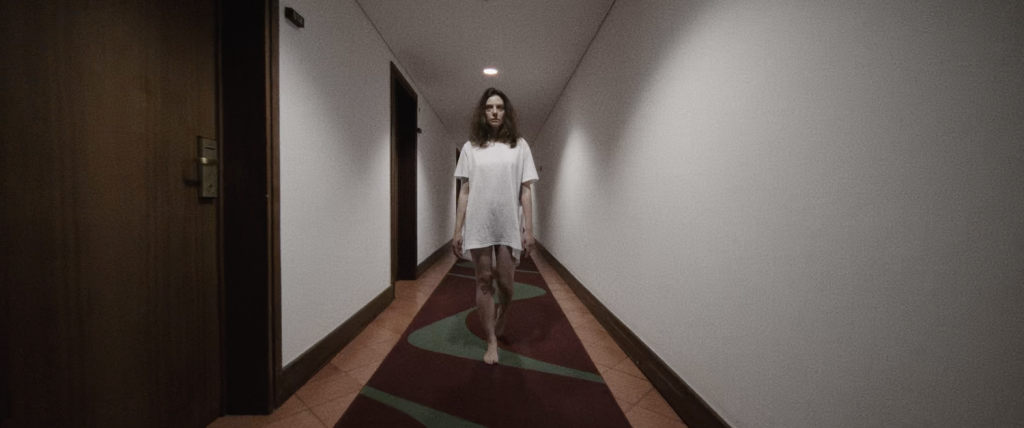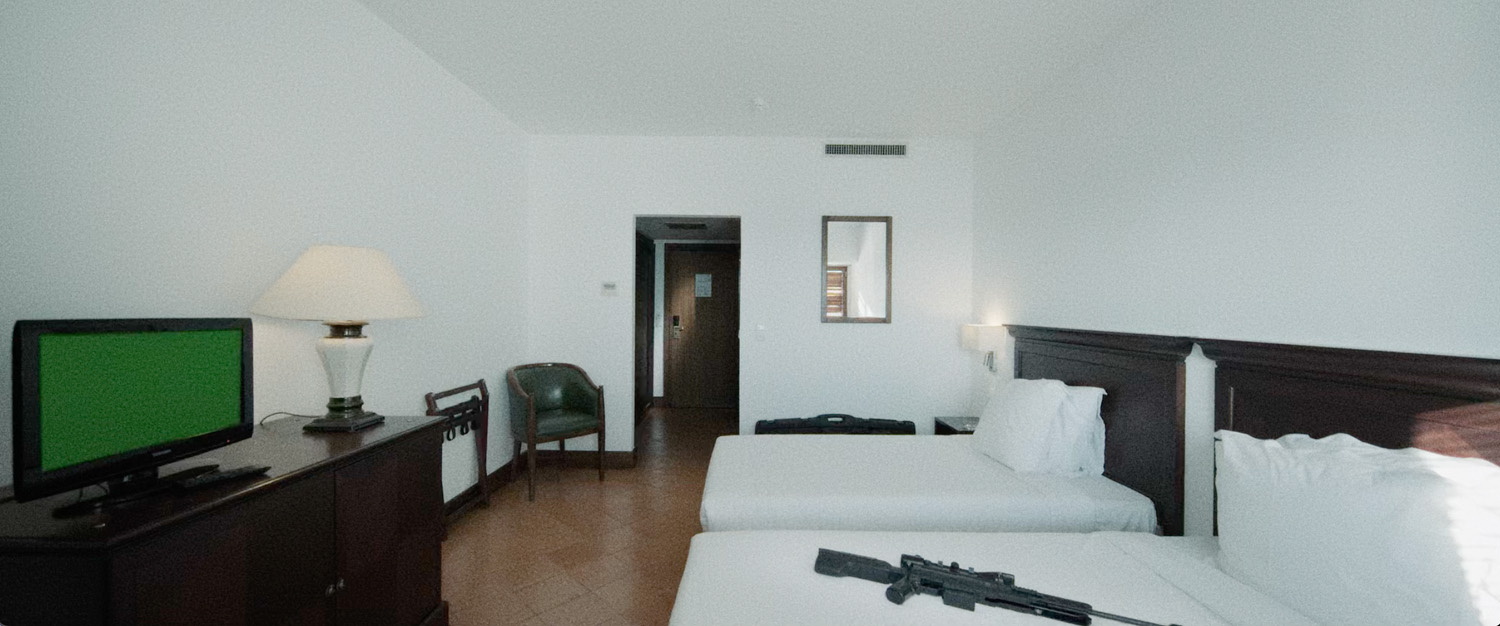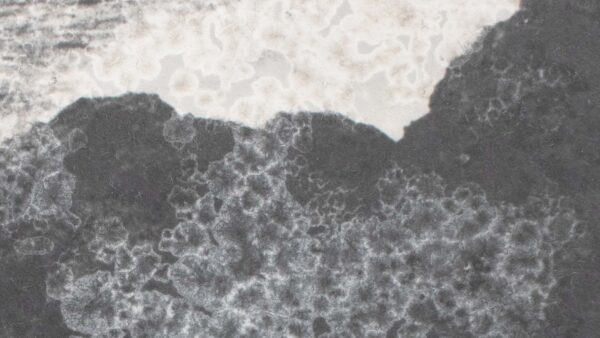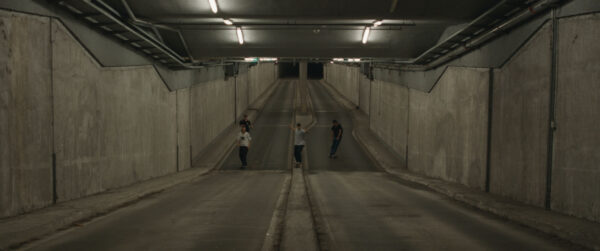Liminal Spaces
Hotel Royal
Hotel Royal is a complete work of fiction that draws heavily from the conditions of its creation, namely the COVID-19 pandemic.

If you peruse certain corners of the internet, you may be familiar with accounts dedicated to cataloging “liminal spaces”, places between one destination and the next. Pictures of desolate corridors under the eerie glow of artificial light, windowless rooms, and patterned carpets, areas in which it seems like time and space remain suspended. The majority of these images are sourced from hotels, being distinctly transitory spaces, rows of identical rooms, that only obtain the slightest impression of human life before being disinfected once more.
The liminal nature of hotels is something well examined within cinema, mined for horror by the likes of Stanley Kubrick and for their impermanence by Chantal Akerman. In Salomé Lamas’ Hotel Royal, liminality is stretched to extreme ends with a voyeuristic exploration of rooms without their inhabitants, where every imprint becomes a signifier and every object a symbol. At only 34, the filmmaker has amassed an impressive body of work, alternating between international festival circuits and art galleries. Her films suggest an eye for the ethnographic, blending fact and fiction with an acute interest in the nature of spaces, particularly what they represent and what a human presence, or lack of it, implies.
Hotel Royal is a complete work of fiction, yet it draws heavily from the conditions of its creation, namely the COVID-19 pandemic. As the narrator remarks early on, “There’s no need to reinvent the world; paying close attention is enough”: one is made to consider the utility of hotels during a pandemic, no longer being spaces to house travellers, but buildings full of mostly empty rooms, either occupied by those returning in quarantine or shut down for good.
Accordingly, to profound effect, the titular Hotel Royal is desolate and devoid of life. Under a pandemic, the pre-existing qualities of the hotel become enhanced, the strange sterility adopts a clinical nature, and the all-white uniform of the chambermaid starts to resemble that of a nurse. The first line of dialogue we hear is from a disembodied voice remarking: “Over the image we hear the repetitive sound of an asthma inhaler being used”. As these breathy sounds continue to recur within the oppressive soundscape presented, it feels like death and disease are interwoven into the film’s fibers.
Hotel Royal itself is built on rigid formal choices, structured as a series of deep dives into the hotel’s rooms. The order of inquiry is as follows: an introduction to the room number, a shot of the entrance, then a shot of the bedroom, all while the narrator describes the room’s objects in great detail. What becomes immediately clear is the disconnect between sound and image. In the film’s first scene, the narrator describes a chambermaid dressed in brown, when in actuality the woman we see is dressed in white, staring at the camera and smoking a cigarette, turning her head, bemused, as if to look for the woman described. As such, we see sound and image as two opposing circuits, complementing each other but failing to match up in other regards. The narrator purportedly adopts the perspective of the chambermaid but acts more like an omniscient watcher, seeking to describe and diagnose the contents of each room, extracting meaning like an embittered semiotics professor, dropping literary references to rationalise the conditions of its inhabitants.
The majority of the rooms presented are identical, featuring a white bed surrounded by four white walls, with a TV set to a blindingly white screen, as if we are being checked into a purgatorial state. Regardless of their blandness, the narrator exposes us to what their crevices reveal: an imprint on a bed could suggest the couple that slept on it did not touch it, or lines of cocaine next to a copy of The Economist could imply the occupant’s wealth. In each room, objects are no longer just objects but signifiers of interpersonal relations, socioeconomic standings, or the current state of the world.

Hotel Royal
The constant analysis eventually reveals the narrator’s wry sense of humour, a messy family’s room triggers a recollection of Tolstoy’s musings on unhappy families, while the presence of cheap travel tickets causes them to remark: “Everything is revealing, people who aren’t afraid tend to sleep well”. The hotel cannot help but feel like an allegorical tool, a seemingly egalitarian world in which all inhabitants are provided the same blank slate to work within, yet, personal effects tow in the baggage of the outside world.
There are plenty of obvious gestures towards the outside conditions under COVID-19, including the aforementioned cheap travel tickets as well as termination contracts. But the dour global mood is further refracted within the conditions of two rooms, which bizarrely diverge from the norm and appear downright apocalyptic. The first of which resembles the home of an elderly person, with yellowing newspapers stacked against the wall and decaying furniture. The narrator remarks the room smells of “urine and loneliness” and surmises the person will die soon. On the flip side, another room is shown completely wrecked, with mattresses overturned, a fallen disco ball, and an assortment of computers scattered around. If it was not obvious enough that this room belonged to younger people, the narrator remarks that sprawled on the bathroom mirror is the phrase “No Future”.
Together, these rooms form a Rorschach test for the viewer, allowing them to project their anxieties and ponder what these conditions represent, recalling everything from the current pandemic, ecological degradation, and the unlivable conditions fermented under capitalism. One thing made clear is that our current global mood reflects a time where imminent death and destruction feel certain for anyone, regardless of age. However, during these scenes, the detachment between image and sound becomes more and more obvious. For example, though we are told what’s written on the mirror, the mirror we see is completely untouched. To a cynical viewer, the narrator could be filling in gaps the director could not afford to present, yet something genuinely interesting happens when sound and image fail to match. The image no longer becomes literal, but a semiotic launching point in which the narrator extrapolates details based on mood.
The film forces the viewer to play an active part in its creation, as we visualise the narrator’s descriptions in our heads. Perhaps the scene that pushes the interplay between narrator and viewer further is when the narrator describes a room full of male paraphernalia: leather gloves, sports bags, and so on. Instead, what we are shown is a single gun on a bed, the implied essence of the items are summarised by the gun, suggesting an underlying aggression and violence tied to traditional signifiers of masculinity. But while the viewer is on the verge of forming this thought themselves, the narrator interjects stating: “All you have to do is choose to stop thinking. No monster. No evil. Evil is banal”, instructing us to overlook the weight of the symbol.
By parsing through the disparate layers of sound and image within Hotel Royal, one is able to uncover the film’s many pleasures. Frequently, the sharp interjections of the narrator feel like footnotes playing out in real-time. We are treated to musings such as: “On objects: they are the massive redesign of the planet by mankind”, which, though didactic, provide both guiding points in which to analyse the film and something deeper to ponder on. Perhaps the most significant comment uttered is “Images aren’t copies; they are models”, a condensation of the film’s semiotic thrust. Divorced from the narration, what does stick with you is the film’s eeriness, its desolate spaces and chilling soundscapes. If you pay close attention, you start to notice strange details in the backgrounds, the most obvious of which is an all-white figure that lurks within frames unacknowledged. In one of the final scenes, the narrator describes a bloody shootout happening in a room, yet all we see is the white figure under a blanket; the omission of visual aid makes the scene all the more disturbing.
If anything, Hotel Royal is a film that revolves around the constant dialogue between the narrator and the image and the narrator and the audience. In this way, the film cleverly draws links to another disembodied voice which we converse with and demand answers to lofty questions from Siri. In a scene merely described, a young boy uses the hotel computer and provides Siri with a litany of questions and statements: “Siri what is love?”, “Siri, I am sad”. In perhaps the film’s most crushing moment the boy professes to Siri: “I can’t see you”.
Amidst the questions raised regarding death and the pandemic, this scene best encapsulates the ethos of Hotel Royal. A world not unlike our own, where human contact is so detached physically and emotionally that it’s experienced in the third person, where we can only understand others by the objects they leave behind, where we can only see but not touch or hear and not see. As the narrator muses: “I’ve always liked objects, they’re easier than people”.




There are no comments yet, be the first!